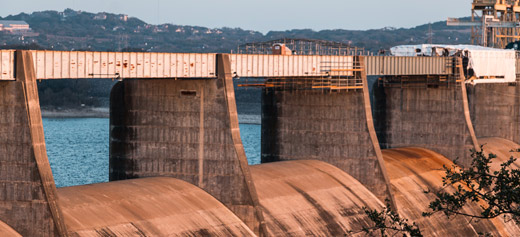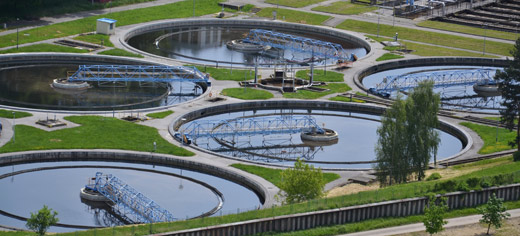Texas saddles up for the “Water Utility of the Future"

In order to meet the water needs of urban and suburban populations across the United States, utilities are undertaking long-term planning that accounts for the risk and uncertainty of droughts and flooding, while ensuring that adequate reserves are maintained to refresh groundwater supplies and freshwater flows for the environment.
These planning exercises are especially critical to urban populations in the state of Texas.
Texans endured a historic drought in the 1950s as well as a notable drought in 2011. The state also faces periodic, sometimes catastrophic, flooding associated with tropical storms and hurricanes that approach from the Gulf of Mexico. Further, water managers strive to protect sensitive freshwater bays, estuaries, and aquifers while also procuring sufficient potable water supplies _to meet demand in Texas’s rapidly growing metropolitan areas. The challenge is compounded by the aged state of water infrastructure systems and the increasing impact of climate change.
Water utilities must decide how to move beyond conventional business and financial models in order to address these challenges head-on. A utility’s long-term water plan has as much to do with forecasting supply and demand as it does with envisioning the “Water Utility of the Future.”
In Texas, as in many other parts of the world, water stakeholders view the adoption of integrated urban water management approaches, such as One Water, as a hallmark of the Water Utility of the Future. Notably, Austin Water and San Antonio Water System (SAWS) are both engaged in long-term planning processes that embrace aspects of the One Water philosophy in the cities of Austin (Water Forward) and San Antonio (2017 Water Management Plan), respectively.
On a more granular level, however, the Water Utility of the Future is defined by four key principles: 1. reflective of the “true cost of water”, 2. sustainable, 3. resilient, and 4. integrated. These principles are integral to a One Water approach and, if woven into future business and financial models, will allow water utilities in Texas to blaze the trail to the Water Utility of the Future.
Reflective of the “True Cost of Water”
Water sustains life, human and otherwise, making it one of the most valuable commodities on the planet. However, there is no other commodity whose true value so far exceeds its nominal price point and whose price is so low compared to the real cost of delivering clean water. Water utilities must source, clean, treat, distribute, drain, and recover water supplies, and these services require substantial operating, maintenance, and capital improvement costs. U.S. residents pay significantly less for water and use significantly more compared to most other countries.
While the price of water in the U.S. does not reflect its true market value, prices are slowly increasing. The price of water in the 30 major US cities increased by 4 percent in 2017 (including Austin and San Antonio), which reflects an increase of 52 percent since 2010. This historical rate of increase amounts to a difference of only a few dollars in monthly water bills year to year. Projected increases, however, in water pricing that reflect water scarcity adjustments and infrastructure investments will be much steeper in the near-term.

It is estimated that at least $1 trillion will need to be invested to refurbish aging water infrastructure over the next 25 years and $36 billion will need to be invested by 2050 to adapt water systems to deal with the impacts of climate change. Utilities must consider novel financing solutions for capital investments, including federal and private funding as well as creative fee structuring and revenue generation.
For example, the revenue generated from Austin Water’s Capital Recovery Fee, which is charged to developers to install new connections, has allowed the utility to effectively manage its debt and pass on the savings to ratepayers through a rate decrease effective May 1, 2018.
Pricing water towards full cost recovery is also essential to ensuring revenue stability for water utilities in the face of water scarcity and much-needed infrastructure investments. Raising the price of water has been difficult in the past because of concerns regarding water affordability and rate shocks. Water prices are projected to increase to four times current levels over the next few decades, and cities are expected to experience the greatest difficulties with water affordability.
While there is general agreement that water is at once essential to life and a commodity, there is less agreement on how to regulate pricing of this commodity, especially with regards to lower-income households across the U.S. The Water Utility of the Future must strike a balance as it assesses how best to structure revenue and business models to meet dual needs. SAWS, for example, has taken steps to address water affordability concerns by offering an Affordability Discount to eligible low-income residential customers.
Sustainable
A sustainable urban water utility can generally be defined as one that effectively manages the urban water cycle to deliver the most appropriate use of water across all stages, and in doing so, enhances social, ecological, and economic stability at various scales. Sustainable management practices adopt long-term visioning as well as a holistic approach to understanding systems and their broader impacts.
The juxtaposition between sustainable yields and safe yields when considering groundwater management is an excellent example of the value added by adopting a sustainable approach to resource planning. Safe yields aim to match groundwater withdrawal with groundwater recharge. This approach, however, often oversimplifies the hydrological, ecological, and social aspects of groundwater management, leading to insufficient recharge over time. Alternatively, sustainable yields employ metrics that can ensure the long-term resilience of a groundwater system, explicitly incorporating the needs of the environment.
The Water Utility of the Future must integrate sustainability into its day-to-day operations and capital investment planning in order to appropriately manage the urban water cycle, especially in light of the environmental perturbations associated with climate change. One way of achieving this level of integration is through coordination with city leadership, which can result in the passage of city ordinances. For example, the SAWS Board and San Antonio City Council adopted a Conservation Ordinance in 2014, and Austin City Council is considering an update to Austin’s land development code, CodeNext, which would significantly impact urban watershed protection and stormwater management.

Resilient
A resilient urban water utility is one that is able to withstand, respond to, and quickly adapt to shocks and stresses in order to robustly recover during difficult times and vigorously thrive during good times.
The Water Utility of the Future must be resilient in order to overcome and flourish in the face of the significant environmental, financial, and social challenges that lie ahead. For example, U.S. counties forecasted to experience the largest increases in water demand through 2090, all of which are identified as being near or adjacent to metropolitan centers, are located in Texas, California, and isolated portions of the Mid-West, Southeast, and Mid-Atlantic. Like resilient cities, resilient water utilities must also embody seven core qualities: 1. reflectiveness, 2. resourcefulness, 3. robustness, 4. redundancy, 5. flexibility, 6. inclusiveness, and 7. integration.
The Water Utility of the Future must also develop business models that will facilitate financial resiliency. In this context, financial resiliency is the ability to thrive under fiscal stress that threatens to temporarily or systematically move the utility off-balance or out of fiscal equilibrium.
Achieving financial resiliency requires a water utility to embrace long-term planning that considers the impacts of climate change, future infrastructure requirements, and customers’ responses to changing revenue and business models. For example, Austin Water has adopted consumption-based fixed rate billing to stabilize revenue.

Integrated
Integration is a fundamental component of the One Water philosophy and a core determinant of success for the Water Utility of the Future.
Integration must occur across water systems (water, sewer, stormwater, and waste), water sources (desalination, new or alternate groundwater, new or alternate surface water, recycling, and/or rain collection), and infrastructure systems. The concept of integrated urban water management has been an active area of research for more than 30 years, and advancements in this field remain critically important today.
Traditional water systems are centralized and often managed in silos according to the service provided; water treatment, distribution, sewerage and storm drainage, and wastewater treatment.
Water experts now advocate for a hybrid approach that combines centralized and decentralized systems and integrates management across these systems. While privatization of water services has been suggested as a way to manage water utilities of the future, serious concerns regarding the potential for enhancement of existing silos as well as a decrease in ratepayer confidence remain.
The diversification of water sources that supply urban residents is essential to maintaining a sustainable and resilient Water Utility of the Future. Successful adaptation to climatic extremes, especially with regards to drought, requires long-term contingency planning, water source diversity, and adaptive management. Towards meeting this goal, the Water Utility of the Future must make strategic capital investments and advance new regulatory approaches and programmatic solutions that support improved supply- and demand-side management.
Green infrastructure, low-impact development, efficiency programs, and novel water, waste, and sewer treatment can all complement traditional water sourcing strategies like transmission pipelines, reservoirs, and aquifer storage and recovery. For example, SAWS boasts the nation’s largest recycled water delivery system and has significantly diversified its water supply portfolio over the past several years.
Next Steps
The One Water concept centers on coordination across diverse stakeholder groups, including multiple players who are involved in the financial, economic, environmental, and equity dimensions of water management. Water utilities, however, are especially well positioned to drive the adoption of integrated urban water management practices given their central role in water planning, maintenance, and operations. Forward-thinking utilities like Austin Water and SAWS are leading the way, but there is more work to be done. Now is the time for water utilities in the state of Texas to move to the Water Utility of the Future.
Dr. Margaret Cherne-Hendrick is a senior science policy associate at Boston University’s Institute for Sustainable Energy. She is an expert in urban natural gas and water infrastructure systems, smart utilities, climate science, and urban ecology, with experience in conducting and communicating scientific research to affect climate, energy, and sustainability policy and best management practices. Previously, she held research fellowships with the Environmental Protection Agency, Frederick S. Pardee Center for the Study of the Longer-Range Future, and Conservation Law Foundation. Margaret earned a B.A., Biology from Reed College, an M.S., Organismal Biology and Ecology from the University of Montana, and a Ph.D., Geography from Boston University. She may be contacted via Twitter @Margaret8416.
Editor's note: The views expressed by contributors to the Cynthia and George Mitchell Foundation's blogging initiative, "Advancing the state of Water, Texas with a One Water approach" are those of the author and do not necessarily represent the views of the foundation. The foundation works as an engine of change in both policy and practice, supporting high-impact projects at the nexus of environmental protection, social equity, and economic vibrancy. Follow the Mitchell Foundation on Facebook and Twitter, and sign up for regular updates from the foundation.

Hide Full Index
Show Full Index
View All Blog Posts